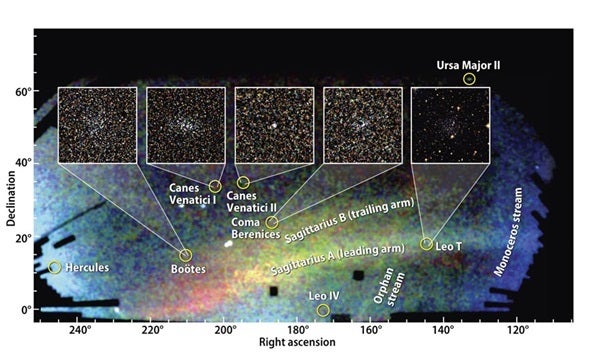While mapping streams of stars coursing through the Milky Way’s halo, an international team of astronomers reports finding seven faint satellite galaxies orbiting our own. An eighth object, discovered in the past 2 months, shows surprising characteristics — and may be the first of a new class of “free-floating” galaxies unbound to the Milky Way.
The seven dwarfs that orbit our galaxy lie between 100,000 and 700,000 light-years away. “They are so incredibly diffuse that, when you look at … a photograph of the sky, you will not see these galaxies,” explains Cambridge University’s Daniel Zucker, who presented the findings at this week’s Seattle meeting of the American Astronomical Society.
The team found the new galaxies by processing imaging data from the Sloan Digital Sky Survey (SDSS-II), which covers about one-fifth of the sky around the North Galactic Pole. The astronomers eliminated red, nearby stars. Then, sophisticated computer algorithms churned through the digital data to find groupings of related stars. Two new dwarfs lie in the constellation Canes Venatici, one in Boötes, one in Leo, one in Coma Berenices, one in Ursa Major, and one in Hercules.
Dwarf galaxies contain, at most, a few million stars, but the combined starlight from each of the new systems is less than 100,000 times the Sun’s. “We’re finding lots of them, and they seem to be much fainter than anyone suspected galaxies could be before,” Zucker says. “Perhaps, rather than dwarf galaxies, they should be renamed ‘hobbit galaxies.'”
Based on SDSS-II’s sky coverage and the number of new systems identified, Zucker suggests dozens of similar galaxies await discovery in other areas of the sky.
Several of the newly discovered systems appear to be on the verge of disruption, probably due to the Milky Way’s gravity. “They look as though they’re being ground up,” Belokurov says. In fact, the Ursa Major II dwarf already seems to be in several pieces.
The eighth and newest discovery is the most intriguing. Named Leo T, for its nature as a transition object, the galaxy is about 1.4 million light-years away, on the fringes of the Milky Way’s gravitational influence. “It may be a ‘free-floating’ Local Group dwarf, rather than a satellite of the Milky Way,” says team member Sergey Koposov at the Max Planck Institute for Astronomy in Heidelberg, Germany.
Leo T’s stellar glow amounts to only 50,000 Suns, but some of its stars formed within the last billion years. By contrast, all of the other new dwarfs contain exclusively old stars. Further, radio data indicate Leo T holds a large amount of neutral hydrogen gas — the fuel for making new stars. “This is basically the smallest, faintest, star-forming galaxy known,” Zucker notes.
“Leo T has probably always been very faint, retaining its gas and slowly forming stars in relative isolation,” says Mike Irwin, a team member and Cambridge University astronomer.
“These new discoveries have really pushed the limit of how small a galaxy can be well below what I, and probably most astronomers, would ever have previously imagined,” Zucker says.
Could the Local Group be filled with smaller, fainter galaxies freely drifting through space? “Cold-dark-matter models predict that there should be tens to hundreds more dwarf galaxies in the Local Group than have been observed, if all dark-matter halos are lit up with stars,” Zucker explains. “These discoveries bring the data and the theory closer together,” he says, but he acknowledges there’s still a substantial gap.










